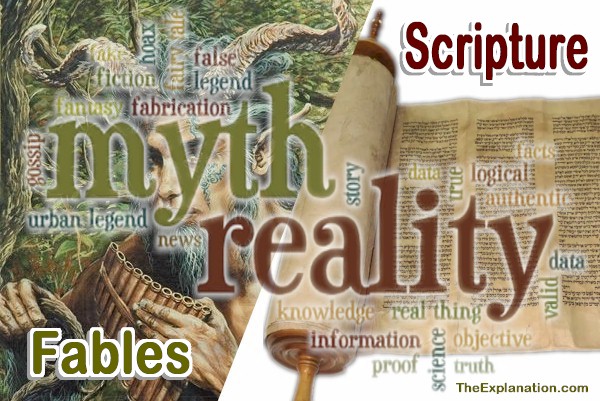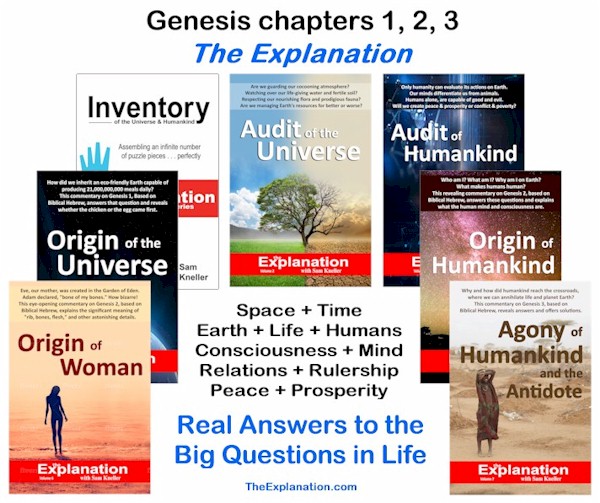Contents
Myth. Norse, Greek, or Roman mythology? Your Choice. These stories are not just fairy tales and film scripts. They have another, more devious and pervasive intent.

Myth or Reality, Fables, or Scripture. What is the real foundation of our beliefs?
Myth. The subtle Serpent made up a story that deceived Eve. It was believable and plausible, and she fell for it. We make up stories for apprentices like, get the glass hammer, for fun and as pranks at the expense of others. Hopefully, everyone gets a laugh, and it isn’t too degrading, which is not always the case. However, there are life myths, so deep-seated that we accept them as truths, and they can be disconcerting.
(Agony of Humankind, chapter 3.2)
Here’s a dictionary definition that, in my opinion, addresses the primary aspects.
A traditional or legendary story, usually concerning some being or hero or event, with or without a determinable basis of fact or a natural explanation, especially one that is concerned with deities or demigods and explains some practice, rite, or phenomenon of nature.
Without a determinable basis of fact or a natural explanation. That’s precisely what The Explanation addresses. Is God mythology? Is the Bible a legend? Is the Serpent traditional folklore?
The Explanation is broaching mythology in the context of the Serpent’s beguilement of the first woman. The Serpent eats dust and destroys humans, as we pointed out. The Serpent disguised lies as truth to Eve and has been doing so ever since (John 8:44). How can you tell the difference between the truth and lies? Between the real and legends?
For we have not followed cunningly devised (G4679) fables, (G3454) when we made known to you the power and coming of our Lord Jesus Christ, but were eyewitnesses of his majesty.
This verse, written by the Apostle Peter, contrasts two opposing foundations of reasoning. Eyewitness accounts on one side and cunningly devised fables on the other. Peter’s eyewitness narrative continues in the next two verses, “17 For he (Christ) received from God the Father honour and glory, when there came such a voice to him from the excellent glory, This is my beloved Son, in whom I am well pleased. 18 And this voice which came from heaven we heard, when we were with him in the holy mount.”
Peter is referring to a personal experience that he and only two other humans, John and James, witnessed. The transfiguration of Jesus when His face shined like the Sun and His clothes were white as light. This account is at the beginning of Matthew 17. I suggest you read it in your Bible or go over to UnlockBibleMeaning.com and read it there. Penmanship fails me to imprint on you (and me) the indelible impression this experience must’ve seared into the minds of those three future Apostles. That is the eyewitness account Peter records in his second Epistle; this was one of the most real, vivid, fearful, yet eye-opening experiences of his life.
Peter is reminding us of his in-person testimonial a little time before his own death. “Knowing that shortly I must put off this my tabernacle (Peter’s physical body), even as our Lord Jesus Christ has shewed me. Moreover, I will endeavour that you may be able after my decease to have these things always in remembrance,” (2 Pet. 1:14-15). He wants us NEVER to FORGET what he knew for CERTAIN. Peter’s experience did not have a natural explanation, but it was a non-debatable fact NOT tradition or a legend. It’s your choice to take it or leave it.
In total contrast to his eyewitness account, Peter emphasizes what he did not follow, cunningly devised (G4679) fables.
σοφίζω sophizō sof-id’-zo; From G4680; to render wise; in a sinister acceptation to form sophisms that is continue plausible error:
KJV – cunningly devised make wise.
Peter uses sophizo (from which we get the name Sofia, wise) referring to fables in the sinister fashion, plausible error. Can we appreciate the way Strong has expressed this meaning in his concordance? Here’s wisdom used to make wrong appear right, to give credence to lies, to tell tales that could’ve taken place. This activity is the wrong use of wisdom. It reminds me of sakal-wisdom (please revise the meaning at this link), the precise type the Serpent told Eve she’d receive on eating from the forbidden tree. It is sinister, dark wisdom. The fables described here, by Peter, are not contemporary instant fake new events, they are traditions and legends passed down over hundreds, even thousands, of years. As Strong adds continue plausible error. It is error that transmits through the generations.
The Greek word sophizo (G4680) is only used twice in the New Testament. The other place is in Timothy.
15 And that from a child you (Timothy) have known the holy scriptures, which are able to make you wise (G4679) to salvation through faith which is in Christ Jesus.
16 All scripture is given by inspiration of God, and is profitable for doctrine, for reproof, for correction, for instruction in righteousness:
The contrast in references cannot be more poignant. The Apostle Paul, writing to Timothy, a younger servant of God, says that it is the HOLY SCRIPTURES that make WISE. Scripture in the form of the Old Testament, which had been passed from generation to generation for hundreds of years. From verse 15, we see Timothy had learned these Scriptures from his youth.
On one side, we have the Bible, which some, maybe many, consider legends, Which Paul said ALONE reveal the wisdom that leads to SALVATION, being SAVED, receiving LIFE. On the other side the fables, that continue plausible error spread by false prophets who end in swift destruction (read 2 Peter 2:1), that is DEATH. Does this remind you of something? How about the two trees in the Garden of Eden. God’s Word regarding the Tree of LIFE opposed to the Serpent’s plausible error about the Tree of KNOWLEDGE (sakal-wisdom, the cunningly devised error) that leads to DEATH.
The whole Bible, the Old and New Testaments, presents the same narrative. There’s God’s Word, Holy Scripture, that alone leads to salvation, which is being saved from death. And there’s opposition to God’s Word, fables which leads to destruction.
The deceiving, conniving, cunning, beguiling Serpent is behind the fables. What are these fables Peter brought to the Church member’s attention? Here’s the Greek he used to write to them.
μῦθος muthos moo’-thos; Perhaps from the same as G3453 (through the idea of tuition); a tale that is fiction (myth):
KJV – fable.
Does muthos sound like a word with which you’re familiar? How about myth? Check this link to see that this Greek word is indeed at the origin of the English myth. Let’s follow the Greek etymological trail and dive into G3453 for more enlightenment.
G3466 μυστήριον mustērion moos-tay’-ree-on; From a derivative of μύω muō (to shut the mouth); a secret or mystery (through the idea of silence imposed by initiation into religious rites): KJV – mystery.
Initiation into secret religious rites in silence.
I would like you to retain that. Why? Because that’s where we find the man and the woman in Genesis 3:8; they are hiding in the midst of the trees in the Garden of Eden. This scenario is at the foundation of so many myths and rituals. Just about all magical, mysterious sorceries take place in a dark forest. We find this throughout the history of ancient Israel in the Old Testament. Here it is referred to as a grove. Not a full-fledged forest because the terrain does not lend itself to such abundance. But, instead, clumps or clusters of trees so they could be secluded and secretive. “And they (the Israelites) left all the commandments of the LORD their God, and made them molten images, even two calves, and made a grove, and worshipped all the host of heaven, and served Baal” (2 Kings 17:16).
Many enchantments take place in dark and even forested places! We don’t have space here to develop this subject but go and do a little research on this topic. Search for “sacred grove” and “enchanted forest.” Even Harry Potter has one! Realize the number of modern stories with this myth as their foundation. We’ll look at a few of these fables and focus on trees in Germanic paganism.
Trees hold a particular role in Germanic paganism and mythology, both as individuals (sacred trees) and in groups (sacred groves). Tacitus, the Roman historian, states that Germanic cult practices took place exclusively in groves rather than temples. The origin is the mythological role of the world tree. This tree is present is all mythologies, worldwide, American pre-Columbian cultures, Baltic, Iranian, Judeo-Christian, Norse, Greek, Roman, North Asian, Siberian, Mongol and Turkic cultures, Hinduism and Indian religions. You ought to ask, why?
The tree finds its way into Gothic architecture in the form of columns that rise from the floor to the ribs of the vaulted ceilings. Does the height and spreading branches remind you of anything? In God’s Temple, there are no pillars.
The world tree in Teutonic mythology is called Yggdrasill, which means the Horse (Yggr) of “the terrible one,” who is Odin, the chief god. This tree is in Asgard, which is the home of the gods and goddesses (Myth tends to use capital G’s for these, but I prefer to use small g, and you understand why). The gard in Asgard means garden. Interesting, to say the least, it should remind you of the Trees in the Garden of Eden. Myth is counterfeit truth.
The tree’s branches extend up and beyond the heavens. The roots are deep, trees, in mythology, represent the link between Earth and Heaven, the underworld below, and the goal of humans, where the gods are, above. For Yggdrasil, some historical evidence also connects individual deities to both groves and individual trees. After Christianization, trees continue to play a significant role in the folk beliefs of the Germanic peoples.
This mythology finds itself in literature, song, theatre, and opera (Wagner, Mozart). The Grimm brothers were famous for collecting the oral myths and editing them in the mid-1800s. You can listen to some of this lore here. You will immediately recognize these tales by their names: Hansel and Grethel, Snow White, Rapunzel, Sleeping Beauty, Cinderella, and Little Red Riding Hood, among others. All made famous and well-known through Disney Studios. Today’s children’s stories draw on ancient mythology.
You can check this website from the University of Michigan to find the meaning of this myth and symbolism of several prominent items: blindness, blood, dragon, eagle (read this one), eyes, garden, river (read this one to see its association with the rivers that issue from the Garden of Eden), three, sword, tree, water, wolf.
I hope you see what’s happened and is happening here. The world is being fed false information. And the Apostle Paul says, “And no marvel; for Satan (the Serpent) himself is transformed into an angel of light,” (2 Corinthians 11:14). Just read this short paragraph to see how true that is. In mythology, the Serpent commands respect and reverence! A wolf in sheep’s clothing. The origin of myth for humankind is right there, with the Serpent, in the Garden of Eden.
Mystery
Above, we saw that the basis of the Greek word for myth is G3466, mustērion, a secret or mystery (through the idea of silence imposed by initiation into religious rites). The KJV has translated this with mystery. John used the term in Revelation to refer to two opposing concepts.
But in the days of the voice of the seventh angel, when he shall begin to sound, the mystery (G3466) of God should be finished, as he has declared to his servants the prophets.
Revelation 17:5
And upon her forehead was a name written, MYSTERY, (G3466) BABYLON THE GREAT, THE MOTHER OF HARLOTS AND ABOMINATIONS OF THE EARTH.
See the contrast? On one side God’s Word. On the other, Babylon. Please, please note that this Babylon is the mother of the abominations of the EARTH. In other words, not just one fable and myth but ALL FABLES of ALL nations around the ENTIRE WORLD. See verse 15, “The waters which you saw, where the whore sits, are peoples, and multitudes, and nations, and tongues.” Once again, here’s the link to the world tree myth and all the peoples around the world who have incorporated this and many other myths into their cultural and religious beliefs. It is little-known knowledge, but it is a worldwide phenomenon.
Behind all this uproar and fake-truth is the Serpent, “And he laid hold on the dragon, that old Serpent, which is the Devil, and Satan, and bound him a thousand years, And cast him into the bottomless pit, and shut him up, and set a seal upon him, that he should deceive the nations no more,” (Revelation 20:2-3). The Devil started deceiving the man and the woman in the Garden, right from the start. And ever since, it has been working to brainwash humanity with its guile and deceit in the form of myth.
According to John and the book of Revelation, there are only TWO MYSTERIES, God’s, and the Serpent’s. The Serpent’s mystery has different national contours, but the root is the same deceptive lie. It is essential to grasp this because of what a lot, if not most Bible scholars, will tell and teach you. Unfortunately, this even goes for teachers who say they believe in the Word of God (2 Corinthians 11:13-15). There’s the false comprehension that LEGENDS, known at the time, are the BASIS for the authorship of many of the BIBLE narratives. They say, for instance, that the Babylonian or Sumerian creation legends are the origins of the Bible Creation story. NOTHING COULD BE FURTHER FROM THE TRUTH.
The Explanation departs from one given. In Genesis, God is on the scene FIRST, presenting His Plan to Adam and Eve, His people. Put another way, God’s Word, His Truth, was the first knowledge revealed to humankind. Anything and everything else came AFTER that revelation. ANYthing and EVERYthing else is a lie and twisted truth. This understanding is vital. The Bible is not a compilation of mythological stories written for the Israelites and the rest of the world. It is not merely a collection of fables threaded together to be read as some nighttime story for kids. The Bible is God’s Word. And His Word is Truth (John 17:17).
In the Bible, God comes FIRST. Everything else comes AFTER that fact. This approach is proper theology. If we don’t accept and abide by that fundamental building block, we’re building on sand, and it will collapse. The Serpent would have you believe otherwise about myth. It’s your choice.
This blog post is an excerpt from chapter 3.2 of the book Agony of Humankind.
Dig Deeper into The Explanation
Online Study Courses to Uncover the Mystery of Adam and Eve’s Nakedness… with no fuss. Free video mini-course revealing the God-intended meaning of Scripture via Biblical Hebrew. It’s so easy, it’ll blow you away. Join now and add new motivation to your Bible study.
Join The Explanation Newsletter to stay informed of updates. and future events. No obligations, total privacy, unsubscribe anytime, if you want.
The Explanation series of seven books. Free to read online or purchase these valuable commentaries on Genesis 1-3 from your favorite book outlet. E-book and paperback formats are available. Use this link to see the details of each book and buy from your favorite store.

Since you read all the way to here… you liked it. Please use the Social Network links just below to share this information from The Explanation, Myth or Reality, Fables or Scripture. What to Believe?



Trackbacks/Pingbacks